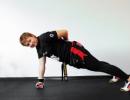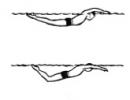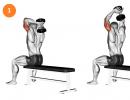How much does a soccer ball weigh in different sizes? Soccer ball: the dimensions of this projectile The ball is a soccer size 5 diameter
Few people know that soccer balls can vary greatly in diameter. But this is one of the important parameters on which the purpose of the ball will depend. Before you go to the store, you should find out what sizes of soccer balls are.
Story
Balls have been man's favorite toy for centuries. They have come to us from ancient times.
Some peoples treated the ball with special respect. For example, the ancient Greeks considered it an ideal subject, since it resembled the sun in shape, which means it had magical powers.
When excavating the tombs of the Egyptian pharaohs, it turned out that the ball was not only depicted on the walls, but was also present in the burials.
Revered the ball and the Indians North America. They personified him with the moon and the sun. This object of perfect form was sacred to them.
Balls were made from everything that was around: from the bark of trees, reeds, skin and even hair. Inside there was also natural material: moss, bird feathers, grain, round fruits. And the Roman legionnaires, along with the ancient Chinese, made balls from the severed heads of their enemies.
Later, the ball began to be inflated with air. The first rubber ball was brought to Europe from Central America by the famous Columbus.
Since then, and to this day, the whole civilized world is familiar with the ball.
How to determine the diameter of a soccer ball
The fact is that when describing the size of balls, the circumference is usually taken into account, and not the diameter of the ball. However, a school geometry course can tell you how to find the diameter of a soccer ball, knowing the length of its circumference.

To do this, the circumference must be divided by the number Pi, that is, approximately 3.14. Practice shows that the actual measurements of the diameter of a soccer ball and the calculated ones are the same.
So, according to FIFA rules, the circumference of the balls should be 68.57 centimeters, and the diameter should be 21.8 centimeters according to measurements. If we calculate the diameter of a ball with a circumference of 68.57 cm, we get 21.8 cm.
There are many interesting logic puzzles on the Internet with the question of what is the diameter of a soccer ball. For example, puzzle lovers are invited to determine the diameter of the ball, having only a wooden ruler in their arsenal.
Soccer ball dimensions
Many would agree that football is one of the most popular sports in the world. In addition, this sport has received national recognition for the fact that everyone can play it. In any clothes and almost anywhere. Of the mandatory equipment - only the ball.
But those who want to play football seriously should know what the circumference, mass and diameter of a soccer ball in cm should be.

To date, soccer balls are divided into five sizes. But you can also highlight the zero size. Officially, such balls are not included in the classification, because they are souvenir.
Its circumference does not exceed forty centimeters. These include very miniature options that do not exceed the size of a key ring.
Size #1
These balls, like the "zero balls", are souvenir and do not exceed 43 cm in circumference. But they are made in the same way as playing balls of classic sizes. In fact, this is a full-fledged ball, just a miniature one. They are usually made from synthetic materials.
Size #2
The circumference of such a ball is from 43 to 56 centimeters. The diameter does not exceed 16.47 cm, and the weight is 283.5 grams. These balls can also be used as promotional balls. They put logos, signatures of football players, as well as advertising slogans.
But such balls can be used for their intended purpose. They are used in training and games of young children. Also, the "deuce" can be an assistant in honing the skill of possession of the ball.
Size #3
These balls are used when training children up to eight years old. Their mass should not be more than 340 grams. The diameter does not exceed 19.42 cm, and the circumference is 61 centimeters. Sometimes "triples" are sewn from 26 or 18 panels, but more often from 32. They are made from synthetic materials and PVC.

Size #4
These are standard futsal balls. In big football, they are used to train children up to fourteen years of age. Such a ball is made from natural materials, such as leather. Weight can range from 369 to 425 grams.
The circumference of the ball of the fourth size is 63.5-66 centimeters. The diameter is in the range from 20.2 to 21 centimeters.
Size #5
It is these balls that are used in big football, including in FIFA matches. They are used in the training of young football players over 12 years old, as well as in all adult competitions.
The diameter of a size 5 soccer ball is in the range of 21.6-22.3 cm, and the circumference varies slightly from 68 to 70 cm. The “five” should not weigh more than 450 grams.
Along with the named sizes, lightweight balls are also used. They may be for women and children. With the above diameter and circumference, the mass of such a ball will be less than officially accepted.
At the beginning of the 19th century, the inhabitants of England, who are directly the founders of football, adopted a certain standard of balls used to play football. It was developed by the English Football Association. What are the characteristics of the ball? Its standard length is 67-71 cm, weight varies from 368 to 425 grams. Surprisingly, the parameters of the circumference have been preserved to the present, but the weight characteristic has undergone changes. The mass of the ball has increased significantly since 1937: by standards from 410 to 425 grams, and since then it has not changed.
In the old days, people also played games similar to the football of our time. The skull of a person or animal then acted as a ball. It was pre-fitted with leather or used bladders various large animals, such as cows or pigs.
Since the 1970s, balls of the same brand, Adidas, have been increasingly used to play at the World Cup. Interestingly, by the beginning of any world football championship, Adidas was improving and creating a new appearance their balls.
Territorially a large number of balls are produced in Pakistan. At the same time, the main production is concentrated in one city - Sialkot.
Unusual is the fact that the balls for official games at the World Cup get their unique name. Moreover, this name was not taken from nowhere, it correlates with the life and features of the country where the Championship is held. For example, for a football forum held in Mexico in the 80s of the 20th century, the Adidas sports company developed a ball, which was named Azteca. On the black parts of this ball, there are patterns of the well-known Aztecs. And in Italy, at a World Cup match held in the 90s, the players played with the ball, which was called "EtruscoUnico", which translates as "Etruscan Lions". In addition to the images of the heads of those Etruscan lions, they contained a mention of the people of antiquity - the Etruscans, who at one time were located on the territory of Italy.
In addition to the mass and circumference of a soccer ball, the rules of the game, which have already been approved, also determine what the ball is made of, its atmospheric pressure, color and even, oddly enough, its shape.
A survey was conducted among football players, and, in their opinion, the best choice would be to purchase UMBRO brand footballs for playing football. Famous football players, world stars of the game and even FIFA experts adhere to the same opinion.
Let's talk about what soccer balls are.
In 1855 the first soccer ball. Its creator was Charles Goodyear. At that time, rubber served as its material. The use of rubber as a material significantly strengthened the ball and increased the rebound characteristics. In the early 1960s, all-synthetic material began to be used to make balls. Then there were balls made of leather shell, but in the late 80s they were replaced by balls made of synthetics. This is due to lower cost, greater softness of the soccer ball and moisture resistant characteristics. Now balls are made from genuine leather or other materials that are suitable for certain parameters.
According to geometric features, balls come in sizes:
- 1st. They have 32 parts. The length of their roundness is not more than 43 cm.
- 2nd. It consists of 26 or 32 parts. The length of its roundness is 56 cm, and the mass is not more than 283 grams.
- 3rd. It consists of 32 parts, weight - no more than 340 grams, and the length of the roundness is no more than 61 cm.
- 4th. It is this size that is the standard for futsal competitions. The weight of the ball varies from 369 to 425 g, and the length of the roundness is from 63.5 to 66 cm.
- 5th. These balls are used in all FIFA World Cups. The length of their circumference varies from 68 to 70 cm, and their weight is no more than 450 g.
According to the international standard, the characteristics of the ball are as follows:
- the ball is made of leather or similar material suitable for playing football;
- the length of the roundness of the ball is standard - from 68 to 70 cm;
- the mass of the ball has also not changed in recent decades and varies from 410 to 450 g;
- during the game, the pressure of the ball must be at least 0.6 atmospheres and not more than 1.1 atmospheres;
- according to the standards, the ball participating in the championship must be 5 sizes.
The FIFA rules, which apply to all football, spell out strict oversight of quality control. In this system, it is established that all balls used under the FIFA mark and participating in competitions must be marked with special signs “FIFA INSPECTED” or “FIFA APPROVED”. In order for the ball to earn such a quality mark, balls from brands such as UMBRO, Adidas, etc., are subjected to many tests. These tests consist of checking the weight of the ball, checking the length of its roundness, moisture resistance, controlling the ball's rebound and its ability to hold pressure.
Many people who are far from football may think that it always has the same size. However, this is far from the case, and if you think so, then you are missing out on many aspects of such as a soccer ball. Its dimensions can vary greatly depending on, for example, for what purposes this projectile serves. There are five sizes in total that do not have any special name, so they are all simply numbered - from first to fifth. So, it's time to find out what size a soccer ball can be. Dimensions can be very important for those people who want to play this sport professionally. If you play football exclusively in the yard with friends, then physical indicators the ball is unlikely to play a particularly important role for you.
First size
What can be such a projectile as a soccer ball? Dimensions start from the first, and the first ball is considered to be the one that has a circumference of 43 centimeters. This is the so-called advertising ball, which is never used for the game. It is created exclusively for advertising and exhibition purposes, so a large number of different logos are always printed on it. People who are a little familiar with this field of activity may at first think that such a ball cannot be played. But in fact, it turns out that it is made from all the same materials as a regular game projectile. The only difference is the smaller size and weight. Accordingly, if you wish, you can safely play football using this soccer ball. Dimensions, of course, do not stop at one - there are four more different types of balls ahead of you.
Second size

If you are wondering what size soccer ball is used in official matches, then you will not get an answer to it yet. The fact is that the second size is also often used for advertising purposes, but not as often as the first. The main purpose of these balls is training, especially for beginner football players, that is, young children. a ball of the second size does not exceed 56 centimeters, and its mass is much less than the mass of a full-fledged ball - about 280 grams. With such shells can work and professional football players- but they use them mainly to improve technique and possession of the ball, which is achieved due to its lightness. As you may have noticed, not everyone immediately understands how it is calculated in the official data, it is far from indicated in the first place - it is traditionally customary to consider the circumference, so it is indicated specifically, as well as the weight of the ball. These are the two main characteristics that determine the size of the projectile.
Third size

This size is also used mainly for training young children, since its dimensions are also small - only 61 centimeters in circumference and 340 grams in weight. Naturally, this is more than the second size, but still not so much to be considered a full-fledged gaming projectile. But of all three sizes, this one is the closest to a full-fledged ball.
Fourth size

This size stands out from the rest, because these balls are designed for futsal. The size of a mini soccer ball is different from that used for a big game. Its circumference does not exceed 64 centimeters, and its weight is 440 grams. But at the same time in this case there are already restrictions on the back of the scale - that is, the ball must be at least 62 centimeters in circumference and at least 400 grams in weight. In balls like this high level other indicators are already being checked, such as the pressure inside the projectile. Moreover, a number of experiments are being carried out to check the quality - for example, if the ball falls from a height of two meters, then its rebound should not exceed 65 centimeters, but it should not be less than fifty centimeters. In general, everything becomes much more strict and clear.
Fifth size
Well, the last size, as you might have guessed, is the balls that are used in all official professional football competitions. Such a ball weighs about 450 grams and has a circumference of 68 to 70 centimeters. It should be noted right away that balls corresponding to this size are the most popular, common and in demand. This is indicated by statistics, thanks to which you can find out that every year more balls of the fifth size are produced than balls of four sizes combined. Therefore, most likely, in your head you associate a soccer ball with a size five projectile, even when you do not suspect that there are more than one size. But now you are aware that the sizes of the balls can be different, in accordance with them, the projectiles are used for different purposes. And each dimension is important in its own way.
The birthplace of futsal or futsal is Brazil, on the famous beaches of which, in the 20s of the last century, a new game, which quickly crossed the borders and gained popularity in most countries of South America.
In 1930, the first rules of the game were developed, and in the 50s, national federations began to emerge, which in 1960 united the confederation of South American countries. On its basis, in 1971, the International Indoor Football Federation (FIFUSA) arose.
In 1982, FIFUSA held the first Futsal World Cup. The game began to spread in Europe, although the rules of the game were somewhat different from the rules established in South American countries. The game differed not only in the rules, in the requirements for goals scored from outside the penalty area, in contact wrestling, in replacing players, but also in the size and weight of the ball. However, thanks to the same roots, between sports disciplines had a lot in common. Combat games were held on the same size grounds, in general, corresponding to handball. Gates are also borrowed from the "handball". There is also a rule adapted from basketball: if the players of the team together committed more than five violations of the rules, each subsequent one is punished with a penalty kick. Game time is limited to two halves of twenty minutes.
The growing popularity of "small football" has attracted International Federation football associations FIFA, which took under the auspices of the kind of "small football", which was guided by the European version of the rules. This game is called futsal.
In 1989, FIFA held the first futsal world championship, the winner of which was ... Brazil. Thus, two competing federations appeared, one of which “played! According to the new FIFA rules, and the other - according to the old ones, from FIFUSA.
In a situation of rivalry between closely related sports, the one that had more financial resources began to win, i.e. mighty FIFA. Naturally, a number of Brazilian futsal players preferred to switch to more promising futsal. The way out of the created situation, i.e. the existence of two parallel organizations could be the entry of FIFUSA into the ranks of FIFA as a collective member. To facilitate integration, FIFA is gradually reforming the rules of futsal, moving closer to futsal. To emphasize the unity of the two games, FIFA renamed futsal to futsal. So now futsal does not exist - there is futsal according to FIFA rules and futsal according to FIFUS rules.
Futsal and futsal in Russia
Already in 1959, i.e. a year after entering Europe, futsal began to be cultivated in Latvia, which was then part of the USSR. Then amateurs in Russia, Ukraine, Azerbaijan, Lithuania and Georgia began to get involved in it. In 1972 Dynamo Kyiv took part in a mini-football tournament organized in Austria. After that, it was decided to use mini-football tournaments as stages of pre-season training for teams major league. Soon futsal was officially recognized: a futsal committee was established within the structure of the USSR Football Federation and the first national championship was held.
After the collapse of the USSR, the Futsal Association of Russia (AMFR), which is part of FIFA, took up the development of futsal. Even earlier, in 1991, the Futsal Federation of Russia arose, which became a member of FIFUSA. The two organizations practically did not intersect with each other in their activities. Each held the Russian Championship in its own way, and each achieved success in the international arena. The Russian national teams, both futsal and futsal, won the European Championships, Russia also has trophies at the youth and women's levels.
Futsal ball size
Historically, in Russia they play a futsal (formerly called mini-futsal) size 4 ball. The weight of these balls is 400-440 g, the circumference is 62-64 cm. At the same time, Select designated such balls as size 3 balls, because objectively they do not fit the FIFA criteria for a size 4 ball, namely, the diameter of the circle must be 63.5–66 cm. called 4. For all models of futsal (mini-football) balls of the design of 2008, the size will be indicated in cm, i.e. the circumference will be indicated.
The Select range also includes the Indoor Five model specifically for the classic futsal, weighing 330-360 g and with a circumference of 64-66 cm, those. Slightly larger and lighter than the traditional Russian size 4 ball. The Indoor Five was developed specifically for indoors, for playing on hard surfaces in cooperation with the federations of the Scandinavian countries. Select refers to his Indoor Five size as 4, but for "our" futsal, it's a size 4.5. Despite the parameters differing from those traditional for Russia, the ball is very popular with buyers.
A soccer ball is also needed for holding training sessions, and for match meetings at the professional and amateur level. For a spectacular and effective game of football, you need not just a round projectile - only sports equipment from branded manufacturers will allow both football players and fans to enjoy the game. The online store site has a rich selection of balls for professional players and for those who are just learning the basics of football. These are models for playing on artificial and synthetic turf, on the ground, on hard indoor surfaces. Equipment from Nike, Adidas, Puma, Select, Uhlsport will last more than one season with different weather conditions and with intense play.
When choosing and purchasing a soccer ball, pay attention to a number of criteria:
coating - natural or artificial turf, ground, gym;
size - children's football (3-4 size), futsal (4 size) and balls for big football(5 size);
Tire material - polyurethane, polyvinylchloride, genuine leather;
type of stitching - thermal stitching (the chamber frame and panels are glued in a special form at high temperatures), manual and machine stitching with nylon thread.
Professional soccer balls used in official competitions under the auspices of FIFA and UEFA receive special licenses based on the results of quality tests:
· FIFA Approved: tests for weight, circumference and sphericity, as well as for moisture absorption, rebound, pressure loss and spherical shape retention after 2000 impacts of a certain force;
· FIFA Inspected or IMS: same tests except for 2000 shots.
The models presented in the online store correspond to international standards and are designed for matches of the highest level.
Brands - manufacturers
The legendary footballs from Adidas should rightfully be put in the first place:
· professional models are certified by the famous football association;
models belong to the middle and high price category;
· Adidas professional soccer balls are used at all major world competitions;
most professional teams football leagues and national football teams use this equipment;
Manufacturing technologies are constantly being improved: new forms of panels are being developed, aerodynamic characteristics are improving, an innovative method called thermal stitching is used in the latest models.
The American concern Nike is a bright competitor to Adidas products: thanks to the use of modern technologies and product quality, the company managed to obtain the status of an official supplier of equipment for the games of professional teams - Nike soccer balls are found at top-level competitions.
Select is not yet such a popular brand, however, soccer balls from this manufacturer, designed for amateurs and professionals, show themselves only with better side. Thanks to the top level of quality and reliability, they are used in games in Russian First division and other official match meetings.
Buy balls at a bargain price
You can buy soccer balls from 320 rubles, of various sizes and characteristics in the online store site: gaming, training, souvenir and high-tech - any model presented in the category corresponds to the description of the manufacturer. Play football, score bright goals and win, and the inventory bought here will help with this!






